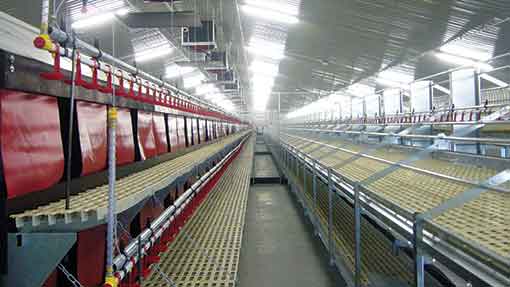Multi-tier units put laying hens on a firm footing

Making the most of a multi-tier system requires careful design and management, as Poultry World reports
The advantages of multi-tier poultry systems for layers are becoming increasingly evident.
“Multi-tier systems allow the birds to express this natural behaviour,” says Jason Docherty, poultry equipment consultant for Potters Poultry. “Birds are more active and therefore healthier. Meanwhile, producers can achieve better stocking density and, with more birds in a smaller space, heat retention is better.
“Birds are also not expending as much energy keeping warm and, as a result, more food goes to egg production and feed bills can fall. The other big benefit is fewer floor eggs.”
But much can be done, from design and planning to management, to encourage flocks to take full advantage of the multi-tier system.
“A new system is a major investment and every aspect has to be right to get the best performance in terms of first quality saleable eggs,” confirms Mr Docherty. “An openly spaced system, one that is not too high with lots of points of entry, will encourage birds into and around the system. It also gives producers good visibility of birds at all times.”
At the design stage all elements of the shed are carefully positioned. “Nest boxes and water lines primarily run down the middle with feeding and perching areas either side. Drinker lines are provided up on the tiers to help ensure birds have easy access to water. From those drinkers, birds should have a direct line of sight to the nest boxes, so we are always reinforcing their natural, required behaviour – to lay eggs in the nest boxes.”
Lighting also plays a vital role. “From day one we use lighting to encourage birds to use the different sections of the shed at the right time,” explains Mr Docherty. “The first light of the day is a glow from the nest boxes, so birds go over and lay their eggs, then drink, feed and go out to the range. Establishing this routine plays a big part in helping to reduce floor eggs.”
Multi-tier systems can also be designed to incorporate technology allowing producers to measure and manage flock performance.
“Food and water consumption are the first indicators of flock health. Being closely monitored in this way allows producers to respond instantly to any changes in feed patterns and correct potential problems. Heat, light, ventilation and pop holes can be controlled via a central control panel. Following installation producers need to be totally confident of how all these controls work and use them for maximum benefit.”
The benefits of multi-tier aren’t out of reach even for producers with flat deck system, adds Mr Docherty. “Many producers are choosing to retro-fit a multi-tier system and this can be done working around existing nest boxes and equipment. The other important issue to consider is that birds entering a multi-tier laying house at 16 weeks should have been reared on a ‘like for like’ system to ensure that they get off to the best start. We are seeing an increasing demand for multi-tier pullets.”
CASE STUDY: Sheila and David Evans, Rhos Cynhinfa Farm, Pont Robert, Powys
Four years ago, as newcomers to the poultry industry, Sheila and David Evans, of Rhos Cynhinfa Farm, Pont Robert in Mid Wales had some very firm ‘boxes to tick’ when choosing their housing.
High bird welfare was a must, as was ease of management. And, with their house nearby, they wanted the system to be as fly-free as possible.
Multi-tier was the obvious answer. “With flat deck, muck is only cleaned out at the end of the 13-month period so can attract flies and vermin,” says Mrs Evans. “With multi-tier, it falls on to a motorised belt which, run twice a week, keeps the house much cleaner. There is a lot less smell, fewer flies and the air is much fresher.”
Rhos Cynhinfa Farm currently has two construction projects on the go – a rebuild of their first multi-tier shed, damaged by a freak snowstorm in March 2013, and a new shed, both fitted by Potters Poultry.
“Each shed will hold 16,000 birds,” says Mrs Evans. “The layout is very straightforward. Nest boxes down the middle, two multi-tiered aviaries along each side. Up on the tiers everything is there for the birds, water and feed and easy access to the nest boxes. What we really like is that it’s not too high: we can see the birds at all times.
“Planning permission took around six months for the second shed,” she adds. “Both sheds will be fitted with control panels allowing us to manage the automatic ventilation fans, the lighting, pop holes and feeders.”
Mrs Evans also appreciates the cost-savings of multi-tier. “The temperature of the buildings, being smaller than a comparable flat deck system, seems to stay more constant and so the birds eat less. With so much going on, and hens moving around the levels, they seem very contented and, having got into a laying routine early on, encouraged by the programmed lighting, there are very few floor eggs.”
